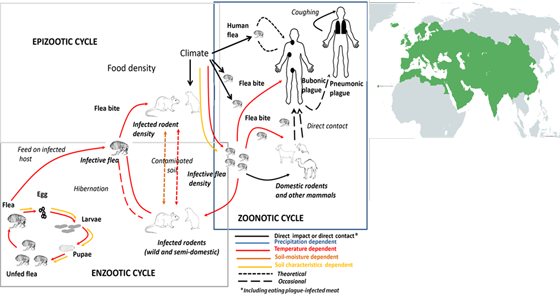The main questions
Synergy-Plague is a multi-disciplinary project to bring our knowledge and understanding of plague, past and present, to new heights. Focussing on the environmental, biological, and societal aspects of plague outbreaks in Eurasia between circa 1300 and 1900 CE, it will address four main questions:
- Why and how did human plague reactivate in the mid 14th century (the Black Death)?
- From where came the many waves of human plague in Europe during the period covering several hundred years after Black Death? Did the bacterium circulate within Europe or did it die out and was reimported from outside Europe several times?
- Why did the European pandemic spread very fast during the Second Pandemic (following the Black Death) and have very high human mortality; as compared to the much slower spread much lower human mortality during the Third Pandemic?
- How and why did the clinical and demographic patterns of human plague infection differ across space and time during the Second and Third pandemics?
- Why (and how) did human plague finally disappear from Europe in the 18th–19th centuries?
The hypothesis: Plague waves and clinical differences resulted from unique alignments of multiple events
Our project is based on the hypothesis that plague waves and clinical differences resulted from unique alignments of multiple events: environmental (climatic and soil-chemical), biological (from individual to ecosystem) and societal (demographic, socio-economic and political).
We will jointly study how plague re-emerged in 14th century Central Asia and radiated repeatedly
Four PIs from the natural sciences and humanities, together with their team members, will jointly study how plague re-emerged in 14th century Central Asia and radiated repeatedly from Eurasian wildlife reservoirs in the following centuries, only to disappear in the 18th-19th centuries. We will develop and analyse new dendrochronological and (paleo-)soil data, textual documentary evidence, and epidemiological models. To understand how plague reached and spread in human populations, paleo-environmental and historical data together with relevant experimental work will be combined with statistical and mathematical modelling. To appreciate why clinical signs and mortality rates varied in space and time, historical evidence will be examined together with new entomological data and ancient DNA (aDNA) of historical plague strains (from humans and anthropophilic rodents). Synergy-Plague will revolutionise our understanding of plague and contribute to our ongoing struggle with epidemic diseases, present and future.
